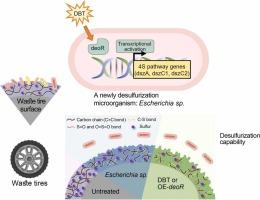Exogenous DBT and overexpression of deoR improved the waste tire rubber desulfurization ability of a newly isolated Escherichia sp. strain
IF 11.3
1区 环境科学与生态学
Q1 ENGINEERING, ENVIRONMENTAL
引用次数: 0
Abstract
The environmental hazards caused by accumulation of waste tire rubber (TR) constitute a major global concern. Microbial desulfurization is an environmentally friendly method for treating waste TR for recycling; it is characterized by mild reaction conditions and low generation of harmful pollutants. Here, we report a new microorganism, Escherichia sp., which was isolated from waste tire surfaces and has the ability to desulfurize TR. Exogenous dibenzothiophene (DBT) increased the cell growth and TR desulfurization ability of Escherichia sp. in a desulfurization medium containing TR. Transcriptomic analysis revealed that TR-only treatment significantly upregulated the expression of the 4S desulfurization pathway gene and six transcription factors, and TR-DBT cotreatment further increased the upregulation of these genes compared with TR-only treatment in Escherichia sp. Overexpression of these six transcription factors in Escherichia sp. revealed that, deoR, was the most effective at increasing transcription of 4S genes and enhancing the TR desulfurization ability. In addition, exogenous DBT and deoR overexpression enhanced the ability of Escherichia sp. to decrease the intensities of C![]() C and C-S bonds and increased the intensities of S
C and C-S bonds and increased the intensities of S![]() O and O
O and O![]() S
S![]() O bonds. Our report establishes a TR desulfurization strategy involving exogenous DBT treatment or deoR overexpression in a new Escherichia sp. strain.
O bonds. Our report establishes a TR desulfurization strategy involving exogenous DBT treatment or deoR overexpression in a new Escherichia sp. strain.

外源DBT和过表达deoR提高了新分离的埃希氏菌对废轮胎橡胶的脱硫能力
废旧轮胎橡胶堆积造成的环境危害已成为全球关注的主要问题。微生物脱硫是一种环境友好的处理TR废物回收的方法;具有反应条件温和、有害污染物产生量低的特点。本文报道了一种从废轮胎表面分离到的具有TR脱硫能力的新微生物Escherichia sp.,外源二苯并噻吩(DBT)在含有TR的脱硫培养基中增加了Escherichia sp.的细胞生长和TR脱硫能力,转录组学分析显示,仅TR处理显著上调了4S脱硫途径基因和6个转录因子的表达。与TR-单独处理相比,TR- dbt共处理进一步增加了这些基因在埃氏菌中的上调。这6个转录因子在埃氏菌中的过表达表明,deoR对增加4S基因的转录和增强TR脱硫能力最为有效。此外,外源DBT和deoR过表达增强了Escherichia sp.降低C=C和C-S键强度的能力,增加了S=O和O=S=O键强度的能力。我们的报告建立了一种涉及外源DBT处理或deoR过表达的TR脱硫策略。
本文章由计算机程序翻译,如有差异,请以英文原文为准。
求助全文
约1分钟内获得全文
求助全文
来源期刊

Journal of Hazardous Materials
工程技术-工程:环境
CiteScore
25.40
自引率
5.90%
发文量
3059
审稿时长
58 days
期刊介绍:
The Journal of Hazardous Materials serves as a global platform for promoting cutting-edge research in the field of Environmental Science and Engineering. Our publication features a wide range of articles, including full-length research papers, review articles, and perspectives, with the aim of enhancing our understanding of the dangers and risks associated with various materials concerning public health and the environment. It is important to note that the term "environmental contaminants" refers specifically to substances that pose hazardous effects through contamination, while excluding those that do not have such impacts on the environment or human health. Moreover, we emphasize the distinction between wastes and hazardous materials in order to provide further clarity on the scope of the journal. We have a keen interest in exploring specific compounds and microbial agents that have adverse effects on the environment.
 求助内容:
求助内容: 应助结果提醒方式:
应助结果提醒方式:


